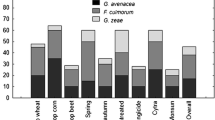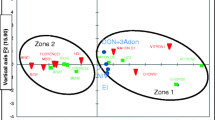Abstract
Avena spp. were artificially inoculated with Fusarium culmorum Sacc. (FC) and F. graminearum Schwabe (FG) causing Fusarium head blight (FHB). This disease is often accompanied by the accumulation of Fusarium mycotoxins mainly deoxynivalenol (DON) in grains. The contaminated grains with this mycotoxin are toxic to their consumers. Genotypes Avena spp. with low DON accumulation in grains can be used as genetic resources suitable for the formation of new resistant varieties of oats against FHB caused by fungi FC and FG. The aim was to find out and to compare the potential for mycotoxin accumulation in grains between genotypes of Avena spp. after artificial inoculation panicles by FC and FG using three spray methods and identify genotypes of Avena (A. abyssinica, A. byzantina, A. canariensis, A. fatua, A. ludoviciana, A. nuda, A. sativa, A. sterilis, A. strigosa) with low toxin accumulation in whole grain. The average accumulations of DON in the grains of Avena spp. gradually increased from the spray inoculation (0.68 mg · kg–1), spray + polyethylene (PE) bag cover 24 hrs (2.75 mg · kg–1) and spray + PE bag/48 hrs. (9.46 mg · kg–1) methods. We found out that after application of each used method, the high DON accumulation in grains was found in A. canariensis, and low DON levels were found in A. byzantine and A. sterilis.
Similar content being viewed by others
References
Bjørnstad, Å., He, X., Tekle, S., Klos, K., Huang, Y.F., Tinker, N.A., Dong, Y., Skinnes, H. 2017. Genetic variation and associations involving Fusarium head blight and deoxynivalenol accumulation in cultivated oat (Avena sativa L.). Plant Breed.. 136(5):620–636.
Boenisch, M.J., Schäfer, W. 2011. Fusarium graminearum forms mycotoxin producing infection structures on wheat. BMC Plant Biology 11:110.
Commission Regulation (EC) No 1126/2007 of 28 September 2007 amending Regulation (EC) No 1881/2006 setting maximum levels for certain contaminants in foodstuffs. Off. J. Eur. Union L. 255:14–17.
Edwards, S.G., Imathiu, S.M., Ray, R.V., Back, M., Hare, M.C. 2012. Molecular studies to identify the Fusarium species responsible for HT-2 and T-2 mycotoxins in UK oats. Int. J. Food Microbiol.. 156(2):168–175.
Edwards, S.G. 2017. Impact of agronomic and climatic factors on the mycotoxin content of harvested oats in the United Kingdom. Food Addit. Contam. A. 34(12):2230–2241.
Fredlund, E., Gidlund, A., Sulyok, M., Börjesson, T., Krska, R., Olsena, M., Lindblad, M. 2013. Deoxynivalenol and other selected Fusarium toxins in Swedish oats – Occurrence and correlation to specific Fusarium species. Int. J. Food Microbiol.. 167(2):276–283.
Gagkaeva, T., Gavrilova, O., Orina, A.S., Blinova, E.V., Loskutov, I.G. 2017. Response of wild Avena species to fungal infection of grain. The Crop Journal. 5(6):499–508.
Gagkaeva, T., Gavrilova, O., Yli-Mattila, T., Loskutov, I. 2011. Evaluation of oat germplasm for resistance to Fusarium head blight. Plant Breeding Seed Sci. 64:15–22.
Gavrilova, O.P., Orina, A.S., Gagkaeva, T., Loskutov, I.G. 2016. Evaluation of resistance of Avena L. genotypes to fusarium infection and accumulation of mycotoxins. Dostizheniya nauki i tekhniki APK. 30(1):25–29.
Hietaniemi, V., Rämö, S., Yli-Mattila, T., Jestoi, M., Peltonen, S., Kartio, M., Sieviläinen, E., Koivisto, T., Parikka, P. 2016. Updated survey of Fusarium species and toxins in Finnish cereal grains. Food Addit. Contam. A. 33(5):831–848.
Hjelkrem, A.G.R., Torp, T., Brodal, G., Aamot, H.U., Strand, E., Nordskog, B., Dill-Macky, R., Edwards, S.G., Hofgaard, I.S. 2017. DON content in oat grains in Norway related to weather conditions at different growth stages. Eur. J. Plant Pathol. 148(3):577–594.
Hofstad, A.N., Nussbaumer, T., Akhunov, E., Shin, S., Kugler, K.G., Kistler, H.C., Mayer, K.F., Muehlbauer, G.J. 2016. Examining the Transcriptional Response in Wheat Fhb1 Near-Isogenic Lines to Fusarium graminearum Infection and Deoxynivalenol Treatment. Plant Genome-US. 9(1):1–15.
Ilgen, P., Hadeler, B., Maier, F.J., Schafer, W. 2009. Developing kernel and rachis node induce the trichothecene pathway of Fusarium graminearum during wheat head infection. Mol. Plant Microbe In.. 22(8):899–908.
Jansen, C., von Wettstein, D., Schäfer, W., Kogel, K.-H., Felk, A., Maier, F.J. 2005. Infection patterns in barley and wheat spikes inoculated with wild-type and trichodiene synthase gene disrupted Fusarium graminearum. Proc. Natl. Acad. Sci. USA. 102(46):16892–16897.
Lásztity, R. 1998. Oat grain – a wonderful reservoir of natural nutrients and biologically active substances. Food Rev. Int.. 14(1):99–119.
Mesterházy, Á. 1978. Comparative analysis of artificial inoculation methods with Fusarium spp. on winter wheat varieties. Phytopath. Z.. 93(1):12–25.
Mesterházy, Á. 2002. Role of deoxynivalenol in aggressiveness of Fusarium graminearum and F. culmorum and in resistance to Fusarium head blight. Eur. J. Plant Pathol.. 108(7):675–684.
Mesterházy, Á., Bartók, T., Kászonyi, G., Varga, M., Tóth, B., Varga, J. 2005. Common Resistance to Different Fusarium spp. Causing Fusarium Head Blight in Wheat. Eur. J. Plant Pathol.. 112(3):267–281.
Meydani, M. 2009. Potential health benefits of avenanthramides of oats. Nutr Rev.. 67(12):731–735.
Nathanail, A.V., Syvähuoko, J., Malachová, A., Jestoi, M., Varga, E., Michlmayr, H., Adam, G., Sieviläinen, E., Berthiller, F., Peltonen, K. 2015. Simultaneous determination of major type A and B trichothecenes, zearalenone and certain modified metabolites in Finnish cereal grains with a novel liquid chromatographytandem mass spectrometric method. Anal. Bioanal. Chem.. 407(16):4745–4755.
Nirenberg, H. 1976. Untersuchungen über die morphologische und biologische Differenzierung in der Fusarium Sektion Liseola. Mitt. Biol. Bundesanst. Land-Forstwirtsch. Berlin-Dahlem 169:1–117.
Othman, R.A., Moghadasian, M.H., Jones, P.J. 2011. Cholesterol-lowering effects of oat β-glucan, Nutr. Rev.. 69(6):299–309.
Proctor, R.H., Hohn, T.M., McCormick, S.P. 1995. Reduced virulence of Gibberella-zeae caused by disruption of a trichothecene toxin biosynthetic gene. Mol. Plant Microbe In.. 8(4):593–601.
Schmidt-Heydt, M., Parra, R., Geisen, R., Magan, N. 2011. Modelling the relationship between environmental factors, transcriptional genes and deoxynivalenol mycotoxin production by strains of two Fusarium species. J. R. Soc. Interface. 8(54):117–126.
Schöneberg, T., Jenny E., Wettstein, F.E., Bucheli, T.D., Mascher, F., Bertossa, M., Musa, T., Seifert, K., Gräfenhan, T., Keller, B., Vogelgsang, S. 2018. Occurrence of Fusarium species and mycotoxins in Swiss oats – Impact of cropping factors. Eur. J. Agron. 92:123–132.
Tekle, S., Dill-Macky, R., Skinnes, H., Tronsmo, A.M., Bjørnstadet, Å. 2012. Infection process of Fusarium graminearum in oats (Avena sativa L.). Eur. J. Plant Pathol.. 132(3):431–442.
Tekle, S., Lillemo, M., Skinnes, H., Reitan, L., Buraas, T., Bjørnstadet, Å. 2018. Screening of oat accessions for fusarium head blight resistance using spawn-inoculated field experiments. Crop Sci.. 58(1):143–151.
Walter, S., Brennan. J., Arunachalam, C., Ansari, K.I., Hu, X., Khan, M.R., Trognitz, F., Trognitz, B., Leonard, G., Egan, D., Doohan, F.M. 2008. Components of the gene network associated with genotype-dependent response of wheat to the Fusarium mycotoxin deoxynivalenol. Funct. Integr. Genomic.. 8(4):421–427.
Welch, R.W. 1995. Oats in human nutrition and health. In: The oat crop – Production and utilization. Ed.: Welch, R.W., Chapman & Hall, London. pp. 433–479.
Xu, X., Madden, L.V., Edwards, S.G. 2014. Modeling the effects of environmental conditions on HT2 and T2 toxin accumulation in field oat grains. Phytopathol.. 104(1):57–66.
Xue, A.G., Chen, Y., Marchand, G., Guo, W., Ren, Ch., Savard, M., McElroy, A.R.B. 2015. Timing of inoculation and Fusarium species affect the severity of Fusarium head blight on oat. Can. J. Plant Sci.. 95(3):517–524.
Author information
Authors and Affiliations
Corresponding author
Rights and permissions
About this article
Cite this article
šLiková, S., Gregová, E. & Pastirčák, M. Toxin Accumulation in Avena Species after Different Spray Inoculation by Fusarium graminearum and F. culmorum. CEREAL RESEARCH COMMUNICATIONS 47, 656–668 (2019). https://doi.org/10.1556/0806.47.2019.43
Received:
Accepted:
Published:
Issue Date:
DOI: https://doi.org/10.1556/0806.47.2019.43




